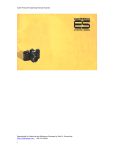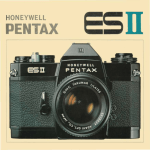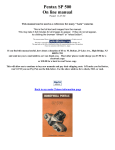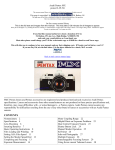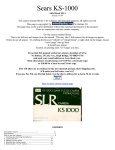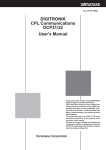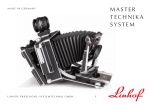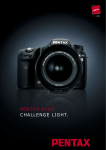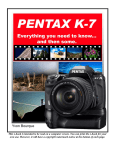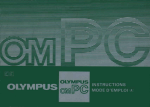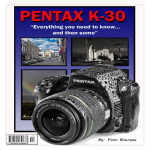Download Asahi Pentax Spotmatic II Instruction Manual
Transcript
Reproduced for Historical & Reference purposes by Paul M. Provencher - http://whitemetal.com Introduction ...................................................................................................................................................... 1 Major working parts of the ASAHI PENTAX Spotmatic II ......................................................................... 2 Specifications .................................................................................................................................................... 4 Short operating course ................................................................................................................................... 6 How to hold your camera ............................................................................................................................... 8 Film Loading...................................................................................................................................................... 9 Film wind and rewind .................................................................................................................................... 10 Bright field focusing....................................................................................................................................... 11 Microprism....................................................................................................................................................... 11 Automatic Diaphragm*...................................................................................................................................... 12 Shutter ............................................................................................................................................................. 13 Cautions..................................................................................................................................................... 13 Depth-of-field guide ...................................................................................................................................... 13 Depth-of-field tables: .................................................................................................................................... 14 Range of light measurement........................................................................................................................ 16 Mercury Battery.............................................................................................................................................. 17 Flash Synchronization ................................................................................................................................... 18 Self-Timer........................................................................................................................................................ 19 Infra-red Photography .................................................................................................................................. 19 How to make deliberate double exposure ................................................................................................. 19 Important Notes ............................................................................................................................................. 20 How to take care of your camera ............................................................................................................... 22 Interchangeable Lenses ................................................................................................................................ 24 Fixed Focus Setting ....................................................................................................................................... 24 Super-Multi-Coated (SMC) Takumars........................................................................................................ 24 DIFFERENCE OF ANGLE OF TAKUMAR LENSES ........................................................................................ 25 SPECIFICATIONS OF TAKUMAR LENSES ................................................................................................... 35 Complete System of Asahi Pentax Accessories for Close-Ups, Macrophotography, Photomicrography, and other Miscellaneous Accessories ...................................................................... 37 Super-Lite II Electronic Flash ...................................................................................................................... 43 Spotmeter III.................................................................................................................................................. 44 ASAHI PENTAX Prism Binoculars................................................................................................................. 45 ASAHI PENTAX Telescopes........................................................................................................................... 46 GUIDE BOOK FOR ASAHI PENTAX SYSTEM OF PHOTOGRAPHY............................................................ 47 WARRANTY POLICY........................................................................................................................................ 49 Reproducers Comments........................................................................................................................................ 52 Reproduced for Historical & Reference purposes by Paul M. Provencher http://whitemetal.com 2 Introduction Your Asahi Pentax Spotmatic II is the finest photographic instrument on the market. The Super-Multi-Coating" on the Takumar lens, developed by Pentax and available only on Spotmatic II Takumars, reduces flare and boosts contrast to a degree far beyond what was previously possible in optical technology. It is a tougher coating than is available on any competitive lenses and results in pictures with more detail and richer colors than is possible with any other system at any price The Spotmatic II itself is an outgrowth and refinement of the original Spotmatic which introduced through-the-lens metering to the world of photography. Its stopped-down metering system is the most accurate method for perfect exposure determination. It also automatically gives you a depth-of-field preview. It is an averaging system for the easiest and most dependable exposures in typical picture-taking situations. This metering system has been refined and improved each year in the Spotmatic to a degree of accuracy unmatched in the industry. The original Spotmatic was the most compact 35mm SLR made. The Spotmatic II retains that same traditional compactness and classic feel. It also is designed for use with the accessories from the Pentax system, including all of the superb Takumar lenses ranging from the ultra-wide-angle 17mm Takumar up to the super-telephoto 1000mm Takumar. The Pentax system can grow with you as your interests develop in any direction. We are very proud of the Pentax Spotmatic II. We are sure you will be, too. Reproduced for Historical & Reference purposes by Paul M. Provencher - http://whitemetal.com Major working parts of the ASAHI PENTAX Spotmatic II A - Shutter Speed Index B - Shutter Speed Dial C - Rapid wind lever D - ASA film speed setting E - Shutter Release F - Automatic reset exposure counter G - 'Cocked' indicator H - D-ring lug I - Self-timer cocking lever J - Focusing ring K - X flash terminal L - FP Flash terminal Reproduced for Historical & Reference purposes by Paul M. Provencher http://whitemetal.com 2 M - Preview lever N - Exposure meter switch O - Film rewind crank P - Film rewind knob Q - Film type reminder dial R - Reminder dial selector S - PF/X switch rim T - Diaphragm ring U - Diaphragm and distance index V - Distance scale W - Exposure counter index X - Depth-of-field guide Y - Hot shoe Z - Hot shoe flash contact Reproduced for Historical & Reference purposes by Paul M. Provencher http://whitemetal.com 3 Specifications Type 35mm single-lens reflex with built-in light meter. Film and Picture Size 35mm film (20 or 36 exposures). 24mm x 36mm Standard Lenses Super-Multi-Coated Takumar 50mm f/1.4 or 55mm Super-Multi-Coated Takumar f/1.8 with fully automatic diaphragm. Distance scale: 0.45m (1.5 feet) to infinity. Filter size: 49mm. With depth-of-field scale. Equipped with diaphragm preview lever which affords visual check of depth of field. Distance Scale: 45cm (18") to infinity. Shutter Focal plane shutter with single non-rotating dial (dial rotates to select shutter speed but remains stationary when exposure is made - this is a reference to earlier cameras that had shutter speed dials that rotated when the exposure was made). Speeds: B, 1-1/1000 sec. Film speed (ASA) setting dial and window on shutter speed dial. Built-in self-timer releases shutter in 5-13 seconds. Shutter curtains of special rubberized silk. Warning Signal The index of shutter speeds turns red when the shutter and film speed settings are off the meter's measurability range. Finder Pentaprism finder with microprism. Fresnel lens for instant focusing; 0.88x magnification with 50mm lens, and approximately life-size with 55mm lens. Focusing Turn the distance scale ring until the subject image in the viewfinder comes into sharp focus. Minimum focus distance: 0.45m (1.5 feet) (With 50/55mm lenses) Reflex Mirror Instant Return Type with special shock absorbers for minimum vibration. Lens Mount 42mm threaded lens mount (Pentax-mount) Reproduced for Historical & Reference purposes by Paul M. Provencher http://whitemetal.com 4 Film Advance Ratchet type rapid wind lever (for film advance and shutter cocking). 10° preadvance and 160° advancing angle. "Cocked" Indicator A red disk appears in a small window alongside the shutter release button when the shutter is cocked, and blacks out when it is released. Film Exposure Counter Automatic re-set type. Flash Synchronization FP & X contacts for conventional flash cord connection. Electronic synchronization at 1/60 sec. Hot shoe with selectable sync (X or FP) Exposure Meter Built-in meter measures the brightness of the ground glass, and couples directly to the shutter and film speed settings. Film speed (ASA) setting ranges from 20 to 3200 (LV118 for ASA 100 film with standard lens.) Meter is powered with a mercury battery. Film Rewind Rapid rewind crank for speedy film take-up. Film rewind button on base of camera body releases film from take-up spool for rewind and rotates while film is being rewound. Loaded Film Indicator Loaded film reminder dial underneath film rewind knob is marked "20" or "36" in green (for color; tungsten type), in white (black and white), in orange (for color, daylight type) and "EMP" (empty). Dimension width 143mm (5.6") x height 93mm (3.66") x thickness 88mm (3.4") Weight 853g (1 lb. 11 oz.) with 50mm f/1.4 lens. Body alone: 622 grams (1 lb, 4 oz.) Reproduced for Historical & Reference purposes by Paul M. Provencher http://whitemetal.com 5 Short operating course A mercury battery for the light meter is packed separately. Be sure to insert it into the battery housing when operating the camera. For battery insertion, refer to page 17. 1. SET FILM SPEED Lift the outer ring of the shutter speed dial, turn it around and set the same number as the ASA number of the loaded film to the small red index which appears alongside the figure 1. Then cock the rapid wind lever. 2. SET SHUTTER SPEED Turn the shutter speed dial and set the speed you wish to use to the index. When outdoors, set the speed to 1/125 sec., or faster, depending upon the lighting. When indoors, set it at 1/30, or in its neighborhood. Change the shutter speed later, when necessary. (Refer to 5 on next page.) 3. COMPOSE AND FOCUS While viewing through the viewfinder, turn the distance scale ring with your thumb and index finger until you get the sharpest image of your subject at the microprism center of the finder Reproduced for Historical & Reference purposes by Paul M. Provencher http://whitemetal.com 6 4. TURN ON THE LIGHT METER SWITCH Push up the switch button with your thumb. Through the viewfinder, you will observe the movement of the meter's needle on the right side of the ground glass. Be sure to turn off the meter's switch when not actually taking readings. 5. ROTATE DIAPHRAGM RING The needle moves up and down with the turn of the diaphragm ring. When the needle rests at the center, you will get correct exposure. If the needle does not come to the center no matter how far you turn the diaphragm ring, change the shutter speed. When the needle is off center and close to the (+) mark, you will get over-exposure: change the shutter speed to a faster setting. If the needle is closer to the (-) mark, you will get underexposure: change the shutter speed to a slower setting. 6. RELEASE THE SHUTTER Hold your camera firmly and trip the shutter. When the shutter is released, the meter switch will automatically turn off, and the needle will remain fixed off and underneath the center. The diaphragm will reopen to its full aperture and the overall image will look brighter. Cock the rapid wind lever for the next picture. (When taking a series of pictures under the same lighting conditions, it is not necessary to repeat instructions 4 and 5.) Reproduced for Historical & Reference purposes by Paul M. Provencher http://whitemetal.com 7 How to hold your camera In horizontal position A. Hold the camera firmly with your left hand, and draw your arm close to your body. In vertical position B. Hold your camera tightly to your forehead with your left hand, and drawn your right arm close to your body. In vertical position C. Hold your camera tightly to your forehead with your left hand, raise your right arm and draw your left arm to your body. As a general rule, your camera should be held more firmly by the left hand which does not release the shutter. If you hold your camera with the right hand - the hand which releases the shutter - it may cause camera movement. Very often, pictures which are not sharp are due to movement of the camera. When you focus with the camera held horizontally (Position A), hold the lens barrel as illustrated. Cradle the camera with your left hand thumb and little finger. Turn the distance scale ring with your thumb and index finger. When holding the camera vertically, some people release the shutter with the thumb (Position B), while others release it with the index finger (Position C). Position C is more desirable for fast focusing and shooting. With the Asahi Pentax, whether held vertically or horizontally, you see your subject image through the taking lens, enabling you to compose, focus and shoot with a minimum of time and effort. Reproduced for Historical & Reference purposes by Paul M. Provencher http://whitemetal.com 8 Film Loading Avoid direct sunlight when loading your film. Film type reminder dial Use the film type dial to show what type of film is in your camera. When you have pulled out the rewind knob to open the back when loading the film, turn the dial selector so that the type of film appears in the window. To check whether the camera is loaded, turn the film rewind knob clockwise. If it turns freely, the camera is not loaded. 1. Open the back by pulling out the rewind knob until the back cover snaps open. 2. Place the film cassette into the cassette chamber, and push back the rewind knob. Draw out the film leader and insert it into the slot of the take-up spool. 3. Advance the film by alternately turning the rapid wind lever and releasing the shutter until both sprockets have properly engaged the film perforations. Close the back by pressing it firmly. 4. If the film is properly loaded, the rewind knob will turn counter-clockwise when you advance the film by turning the rapid wind lever. Setting ASA film speed The ASA film speed rating of all 35mm films is given in the data sheet packed with each roll of film. The higher the ASA number, the more sensitive the film. Lift the outer ring of the shutter speed dial and rotate it until the ASA number of your film is opposite the red index mark. Be sure to set your film speed on the shutter speed dial because the dial is connected to the exposure meter system. Reproduced for Historical & Reference purposes by Paul M. Provencher http://whitemetal.com 9 Film wind and rewind Cock the rapid wind lever for the first picture; the exposure counter automatically turns to '1', indicating that the first picture is ready to be taken. 2 After the final picture on the roll (20 or 36 exposures) has been taken, the rapid wind lever will not turn all the way as you stroke it. This indicates that the final picture has been taken on your film, and that the film must be rewound. Don't open the back of the camera, or all exposed frames will be ruined. 3 Unfold the film rewind crank. 4 Depress the film rewind release button. Turn the rewind crank to rewind the film into the film cassette. The film rewind crank permits rapid rewinding at a smooth, even rate. (Under some atmospheric conditions, erratic or too rapid rewinding will cause static electricity marks on the film.) You will feel the tension on the rewind crank lessen as the leader end of the film slips off the take-up spool. 1 The first portions of the film cannot be used for picture taking as they have already been exposed to light. Generally, two blank exposures should be made before taking your first picture. Cock the rapid wind lever until it stops. Watch to see that the film rewind knob automatically turns counter-clockwise, indicating that the film is moving from cassette to take-up spool. Trip the shutter. Stop rewinding when you feel this happen. AVOID DIRECT SUNLIGHT WHEN UNLOADING YOUR FILM. (The rewind release button will return to normal position as you load your next film and turn the rapid wind lever.) 5 Pull out the film rewind knob (the back will open automatically), and remove the film cassette. Reproduced for Historical & Reference purposes by Paul M. Provencher http://whitemetal.com 10 Bright field focusing 1 You can start viewing and focusing before and after cocking the rapid wind lever. When the automatic preview lever is in the "AUTO" (automatic) position, the meter is at "OFF", the diaphragm is fully open except for the moment of exposure. 2 Turn the distance scale ring until your subject image is clearly in focus. It is not always necessary for you to view and focus with the diaphragm fully open. In bright sunlight, you can easily focus with the diaphragm closed to f/5.6 or f/8 and still observe the depth of field. It is easier, however, to focus with the diaphragm fully open as your subject image is much brighter. When the letters "MAN" appears beside the lever, the lens is in manual position; when "AUTO" appears, it is in the automatic position. Microprism Asahi Pentax cameras have a Fresnel lens with a microprism center underneath the ground glass. As you look through the finder, you will see that the Fresnel lens consists of many concentric rings which provide the brightest possible image on the ground glass. The microprism is the center portion of this diagram. When your subject is in focus, the image in the microprism will be sharp and perfectly clear. If your subject is not in focus, the microprism will break the image up into many small dots, much like and engraver's screen. You can focus your subject on any portion of the ground glass. Reproduced for Historical & Reference purposes by Paul M. Provencher http://whitemetal.com 11 Automatic Diaphragm* OUT OF FOCUS When the preview lever is in the "AUTO" (automatic) position, and the exposure meter is turned to "OFF", the fully automatic diaphragm is at its largest aperture at all times, except for the instant of exposure, no matter what aperture is set on the diaphragm ring. When you release the shutter, the diaphragm automatically stops down to the predetermined aperture and the shutter curtains start travelling instantly. When the exposure is completed, the diaphragm reopens to maximum aperture completely automatically and you are ready to compose, focus and shoot your next pictures. If you wish to visually check exact depth-of-field before making the exposure, move the preview lever to the "MAN" (manual) position. This stops the diaphragm to the aperture selected and shows you exactly how much depth-of-field will appear in your picture. The preview lever may be moved back to "AUTO" (automatic) position before or after making your exposure, or, if you are making pictures in bright sunlight, it may be left in manual position, which permits a constant check of depth of field. * When the exposure meter switch is turn to the "on" position, the lens diaphragm changes from the automatic to manual position even though the preview lever is in the "AUTO" (automatic) position. When the shutter is released, the lens diaphragm will automatically return to its automatic position if the lever is set on "AUTO" IN FOCUS Reproduced for Historical & Reference purposes by Paul M. Provencher http://whitemetal.com 12 Shutter Turn the shutter speed dial clockwise or counter-clockwise to the shutter speed desired. The shutter speed may be set either before or after cocking the rapid wind lever. As you cock the shutter by turning the rapid wind lever, the "cocked" indicator turns red showing that the shutter is cocked. The indicator window blacks out as you trip the shutter button. For use of the X setting on the shutter speed dial, refer to page 18. With the shutter speed dial set on B (bulb), the shutter will stay open as long as you depress the shutter button. As you release your finger from the shutter button, the shutter closes. When a long exposure is desired while using the B setting, attach a shutter release cable with a locking device to the shutter button. This will permit a "Time" exposure. Cautions 1 At slow speeds - slower than 1/30 - support your camera rigidly or use a tripod to prevent movement of your camera. 2 To protect the shutter mechanism, trip the shutter release before putting the camera out of use for any extended period. Depth-of-field guide If you want to know how great the depth of field is at a certain aperture, look at the depth-of-field guide. In the above photograph, the distance scale is set at 5 meters…the lens is focused on a subject 5 meters away. The calibrations on each side of the distance index correspond to the diaphragm setting and indicate the range of in-focus distance for different lens apertures. For example, if the lens opening of f/8 is to be used, the range on the distance scale ring covered within the figure 8 on the depth-offield guide indicates the area in focus at the lens opening. You will note from the depth-of-field guide in the photograph that the range from approximately 10 to 25 feet is in focus. Note that as the lens apertures change, the effective depth of field also changes. For the depth of fields at different apertures and distances, refer to page 14 ~ 15. Depth of field is the range between the nearest and farthest distances which are in focus at different lens apertures. Reproduced for Historical & Reference purposes by Paul M. Provencher http://whitemetal.com 13 Depth-of-field tables: Super-Multi-Coated Takumar 50mm lens Distance Scale \ f setting f/1.4 f/2 f/2.8 f/4 f/5.6 f/8 f/11 f/16 0.45 m 0.6 m 1 m 1.5 m 2 m 5 m 10 m ∞ m 0.45 0.453 .045 0.454 0.44 0.46 0.44 0.46 0.44 0.46 0.44 0.47 0.43 0.47 0.42 0.48 0.59 0.61 .059 0.61 0.59 0.61 0.59 0.62 0.58 0.62 0.57 0.63 0.56 0.65 0.54 0.67 0.98 1.02 0.98 1.02 0.97 1.03 0.95 1.05 0.94 1.07 0.91 1.11 0.88 1.15 0.84 1.24 1.46 1.54 1.45 1.56 1.43 1.58 1.40 1.62 1.36 1.68 1.30 1.77 1.24 1.89 1.16 2.16 1.93 2.07 1.90 2.11 1.87 2.16 1.81 2.23 1.75 2.34 1.66 2.52 1.56 2.80 1.42 3.42 4.57 5.52 4.41 5.78 4.21 6.16 3.94 6.84 3.64 8.03 3.26 10.87 2.88 19.53 2.42 ~ ∞ 8.40 12.36 7.86 13.75 7.24 16.19 6.48 22.05 5.68 42.68 4.80 ~ ∞ 4.02 ~ ∞ 3.16 ~ ∞ 51.75 ~ ∞ 36.24 ~ ∞ 25.90 ~ ∞ 18.14 ~ ∞ 12.97 ~ ∞ 9.10 ~ ∞ 6.63 ~ ∞ 4.57 ~ ∞ Depth-of-field table: Super-Multi-Coated Takumar 55mm lens Distance Scale \ f setting f/1.8 f/2 f/2.8 f/4 f/5.6 f/8 f/11 f/16 0.45 m 0.6 m 1 m 1.5 m 2 m 5 m 10 m ∞ m 0.45 0.45 0.45 0.45 0.45 0.45 0.44 0.46 0.44 0.46 0.44 0.46 0.44 0.47 0.43 0.47 0.59 0.61 0.59 0.61 0.59 0.61 0.59 0.61 0.58 0.62 0.58 0.62 0.57 0.63 0.56 0.65 0.98 1.02 0.98 1.02 0.98 1.03 0.97 1.04 0.95 1.05 0.93 1.08 0.91 1.11 0.87 1.17 1.46 1.54 1.46 1.54 1.44 1.56 1.42 1.59 1.39 1.63 1.34 1.70 1.29 1.79 1.22 1.96 1.93 2.07 1.92 2.08 1.89 2.12 1.85 2.17 1.80 2.25 1.73 2.38 1.64 2.57 1.52 2.95 4.57 5.52 4.53 5.59 4.36 5.86 4.13 6.33 3.87 7.09 3.53 8.65 3.18 11.93 2.73 32.75 8.39 12.38 8.24 12.72 7.70 14.27 7.01 17.48 6.27 24.97 5.41 70.27 4.62 ~ ∞ 3.71 ~ ∞ 51.27 ~ ∞ 46.15 ~ ∞ 32.98 ~ ∞ 23.10 ~ ∞ 16.52 ~ ∞ 11.58 ~ ∞ 8.44 ~ ∞ 5.82 ~ ∞ Reproduced for Historical & Reference purposes by Paul M. Provencher http://whitemetal.com 14 Depth-of-field table: Super-Multi-Coated Takumar 50mm lens Distan ce Scale \ f setting f/1.4 1'6" 2' 3' 5' 10' 15' 30' 1' 6.12" 1' 6.13" 1' 11.8" 2' 0.2" 2' 11.5" 3' 0.6" 4' 10.4" 5' 1.7" 9' 5.6" 10' 7.2" 13' 9.7" 16' 4.9" 25' 6.6" 36' 4.2" ∞ m 169' 9.2" ∞ f/2 f/2.8 f/4 f/5.6 f/8 f/11 f/16 Depth-of-field table: Super-Multi-Coated Takumar 55mm lens Distan ce Scale \ f setting f/1.8 f/2 f/2.8 f/4 f/5.6 f/8 f/11 f/16 1'6" 2' 3' 5' 10' 15' Reproduced for Historical & Reference purposes by Paul M. Provencher http://whitemetal.com 30' ∞ m 15 Range of light measurement The exposure meter of the Spotmatic measures the brightness of the ground glass. Therefore, the meter should be turned on after you have focused your subject on the ground glass. The following table shows the range of the meter's light measurement, and should not be interpreted as the camera's total range of f/stop-shutter speed combinations. As you will note from the table below, with an ASA100 film, you may use any shutter speed from 1 sec. to 1/1000 sec. in combination with any aperture that will bring the meter needle to the midpoint in the viewfinder. The total range of the aperture settings is, of course, determined by the minimum and maximum apertures of the lens being used. For example, with the 50mm f/1.4 lens and ASA 100 film, an aperture from f/1.4 (the maximum aperture of this lens) to f/16 (the minimum aperture) may be used with any shutter speed from 1 sec. to 1/1000 sec. that will bring the meter needle to midpoint. ASA B 1 1 /2 1 /4 1 /8 1 /15 1 /30 1 /60 1 /125 1 /250 1 /500 1 /1000 20 • 25 32 • • • • • • • • • • • • • 40 50 64 80 100 125 160 200 250 320 400 500 640 800 1000 1250 1600 2000 2500 3200 A B The area A indicates the reading range of the meter. The area B indicates that although the shutter speed index is black and the meter needle moves, the meter is NOT operating properly. When the meter needle is centered with the shutter speed dial set at B using ASA 20~50 films, this indicates that the exact shutter speed required is 2 seconds. Please expose your picture for 2 seconds. Reproduced for Historical & Reference purposes by Paul M. Provencher http://whitemetal.com 16 Mercury Battery How to check it 1. Set the shutter speed dial to B (bulb) position. 2. Turn the ASA dial to ASA 100. 3. Push the meter switch to "on" position. Look at the meter's needle through the viewfinder. If the needle rapidly drops, the meter has sufficient capacity; if it does not, replace the mercury battery. How to replace it Open the battery housing cover on the bottom cover plate with a coin. Remove old battery and insert new battery with (+) side toward the top of the camera. For replacement, use Mallory PX-400 or RM-400-R or equivalent. CAUTION: The mercury battery is like a phonograph record. It can be damaged by skin acids. Handle by the edges with a dry cloth only. Be sure the battery is cleaned with the cloth before insertion into the camera. The battery is not rechargeable. DANGER! A serious accident has been reported of a small child who has put a mercury battery into his mouth and has been hospitalized for serious gripes and stomach inflammation. Please always keep a mercury battery from the reach of small children. Reproduced for Historical & Reference purposes by Paul M. Provencher http://whitemetal.com 17 Flash Synchronization The Spotmatic II has FP and X terminals at the front of the camera body, and a separate FP/X contact on the built-in hot shoe. The table below shows which flash contact, which shutter speed and which flash bulb may be combined for maximum lamp efficiency. Unless these combinations are rigidly followed, there will be a failure in flash synchronization. Note the "X" setting is exactly the 60 marked on the speed dial. This indicates the highest shutter speed at which electronic flash units may be used. Use the hot shoe flash contact only when using the Super-Lite II or any other electronic flash or flash gun that has a flash contact on the shoe bracket. To select FP or X, just turn the FP/X switch rim so that either one of the marks appears in the window. When not using these terminals, keep the plugs inserted in the terminals. Flash Terminal \ Shutter Speed FP 1 /1000 1 /500 1 /250 1 /125 1 /60 1 /30 FP Class (Screw Base) FP Class (Bayonet Base) 1 /15 1 /8 1 /4 1 /2 F Class M Class and MF Class X Electronic Flash Reproduced for Historical & Reference purposes by Paul M. Provencher http://whitemetal.com 18 1 Self-Timer Depending on how far down you turn the self-timer cocking lever (1), it will release the shutter in 5 - 13 seconds. When operating the selftimer, always depress the self-timer release button (2) to release the shutter. Do not depress the shutter button … it will immediately release the shutter without delayed action. The self-timer cocking lever should be turned down at least 90° or the release button will not operate. Infra-red Photography If you intend to take infra-red photographs, remember to use the small "R" index marked on the depth-of-field guide. Some of the Takumar lenses, however, like the above picture of Super-Takumar 50mm f/1.4, do not have the "R" mark. The index is just a short orange line. First, focus your lens on your subject. Determine the lens to subject distance from the distance scale. Then match your lens to subject distance to the "R" mark my turning the distance scale accordingly. For instance, if your subject is in focus at infinity, turn the distance ring and move the infinity ( ∞ )mark to the "R" index. The "R" index marking on Takumar lenses is based on the lens setting at infinity. How to make deliberate double exposure For deliberate double exposures, make the first exposure in the normal way. Then tighten the film by turning the rewind knob (1), and keep hold of the rewind knob. Depress the film rewind release button (2) and cock the rapid wind lever. This tensions the shutter without advancing the film. Finally, release the shutter to make the second exposure. Then make one blank exposure, before taking the next picture, to avoid overlapping. Reproduced for Historical & Reference purposes by Paul M. Provencher http://whitemetal.com 19 Important Notes Always keep the meter switched off when not actually taking readings. Leaving the meter switched on will rapidly exhaust the battery. It is also necessary to keep the meter switched off when mounting a SuperTakumar or SMC Takumar lens on the Spotmatic II camera body. If it is switched on, the tip of the automatic diaphragm release pin of the lens will hit the pin release plate inside the camera body and may get damaged. 1 When the index of the shutter speeds turns red, it indicates that the shutter and film speed settings are off the meter's measurability range. Change the shutter speed setting to a faster or slower setting. Refer to page 16. 2 When the meter is switched on, the lens (any Super-Takumar or SMC Takumar lens) is in its manual position, even when the diaphragm preview lever is in the "AUTO" (automatic) position. When the meter is switched off manually, or automatically after shutter release, the lens returns to its automatic position when it is set in "AUTO" position. 3 Reproduced for Historical & Reference purposes by Paul M. Provencher http://whitemetal.com 20 4 Exposure increase factors which apply when taking pictures with filters, close-ups, macro- and micro-photos, do not apply to the Spotmatic 5 Primarily made for use with the Spotmatic II, the Super-Multi-Coated Takumar 50mm f/1.4 can also be used with the original Spotmatic, the models SL and SP 500. Further, it can be used with only two other cameras: Asahi Pentax SV and S1a with an orange-colored R marking on the film rewind knob. Use with any other camera will damage the rear element lens 6 The length of the tripod's screw should not exceed the normal length of 3/16" (4.5mm). Do not extend it longer than this length when mounting your camera on tripod. Forcing longer screws into the tripod socket of the camera will damage the mechanism. No! Reproduced for Historical & Reference purposes by Paul M. Provencher http://whitemetal.com Exposure Factor x1.63 x1.96 x3.20 x4.80 x5.46 21 How to take care of your camera 1. STORAGE a) The instrument, when not in use, should be protected from dampness and dust. Preferably, it should be kept in its case and, as an additional precaution, inserted into a polyethylene bag. b) Care should be taken to see that the camera is not kept in abnormally high or low temperatures - normal room temperature is best. c) Take the precaution of removing any batteries since, no matter how well made these may be, there is always the risk of deterioration and corrosion. 2. EXERCISE All mechanical instruments need to be exercised regularly to keep them in good condition. Cameras are no exception to this rule. If you put your car in storage for the winter, the first thing a prudent owner does in the spring is to have it serviced before putting it back on the road. There is not quite the same parallel between a motor car and a camera, nevertheless, you should store your camera where you can get to it easily and put it through its normal operations at least once per month. i.e. a) Set the shutter release and fire. b) Turn to a slow shutter speed and again set the shutter release and fire. Also operate delayed action device (self-timer). c) Examine the exposure meter for correct operation. d) Check film transport e) Check the range finder or pentaprism viewfinder. These actions will keep the mechanism in good order, retaining the natural qualities of the lubricant - thus ensuring the camera is ready for instant use when required. Reproduced for Historical & Reference purposes by Paul M. Provencher http://whitemetal.com 22 3. RUNNING TEST BEFORE USE Before embarking on a holiday, where your camera will be your constant companion or, in fact, any other reason for the camera being required on an important assignment, make a few trial exposures. It is advisable to test the camera at least four weeks prior to your departure to give time for a test film to be exposed and processed. Many spoiled holiday records would have been avoided if this precaution had been taken. 4. DUSTY CONDITIONS When your camera is used at the beach, or in other conditions where dust or sand can easily infiltrate the mechanism, take the precaution of putting the instrument with its case into a polyethylene bag or other container so that flying dust or sand are prevented from entering the camera. This applies particularly, of course, if it is laid down on a sandy beach. Furthermore, avoid leaving the camera in such a position that direct sunlight is allowed to fall upon it for a long length of time. 5. LOOSE PIECES OF FILM This nuisance is often the cause of trouble with a camera. Small chips of film can easily damage the mechanism. Therefore, check your camera every time it is loaded. Always make sure it is free from small pieces of film. 6. TREATING YOUR CAMERA TENDERLY Your camera is a fine precision instrument. It has been produced with great care and attention to detail. Do not allow it to be swung by its shoulder strap, thrown into the back of a car, or in any way treated as if it were as robust as a battle ship. If you protect the camera against possible damage due to a knock, you will be amply rewarded by years of excellent and trouble-free service. Reproduced for Historical & Reference purposes by Paul M. Provencher http://whitemetal.com 23 Interchangeable Lenses The Asahi Pentax offers many interchangeable lenses in a wide variety of focal lengths, all of which are highly respected by both professional and amateur photographers for their fine resolution. The photographic coverage of various Takumar lenses is illustrated on page 25. With focal length longer than 55mm, the subject image is seen through the viewfinder larger than its life size. Regardless of the lens selected for your Asahi Pentax, there is never need for an accessory viewfinder, ordinarily required for rangefinder type cameras. When interchanging lenses, hold the lens by the distance scale ring. When attaching a lens, filter, or lenshood, do not screw it too tightly, as you may find it difficult to remove. Fixed Focus Setting Because of the considerable depth of field of wide-angle lenses, you can use them as fixedfocus lens if the diaphragm and distance scales are set properly. For your convenience, the Super-Takumar and SMC Takumar lenses shown on pages 26 and 27 (marked with *) have a fixed focus mark. Just align with the index the orange-colored figures of the diaphragm and distance scales, and the lens will be in fixed-focus from foreground to infinity. You'll find this extremely convenient for fast shooting. Super-Multi-Coated (SMC) Takumars Pentax SMC Takumar lenses are the world's first 7-layer multi-coated lenses. A truly remarkable optical achievement. Conventional lenses have only 1-3 layer coatings. The additional coating of SMC Takumar lenses let in more lighting resulting in truer colors. Reflection is reduced to 0.2% allowing the remaining 99.8% of light to pass through. This means higher light transmission, and the brightest lens possible. Colors pass through with equal intensity so color balance is strikingly improved. Brighter blues. Vibrant reds. Truer yellows. SMC Takumar lenses make it possible. And no ghosts or flares even when shooting against the sun. Ultra violet light is reflected off the glass surface. So only true colors are absorbed. Undesired rays are kept out. SMC Takumar lenses are for people interested in the ultimate in photographic lenses. Reproduced for Historical & Reference purposes by Paul M. Provencher http://whitemetal.com 24 DIFFERENCE OF ANGLE OF TAKUMAR LENSES 28mm 50~55mm 85mm 135mm 200mm 400mm 1000mm All photographs were taken from the same location and distance from the subject. Reproduced for Historical & Reference purposes by Paul M. Provencher http://whitemetal.com 25 Fish-Eye Takumar 17mm f/4* The world's most efficient fish-eye lens with maximum brightness of f/4. Covers an angle of vision of about 180°. Enables you to view and focus through the viewfinder without keeping the reflex mirror flipped up. Lens element 11 (including 3 filters) Minimum aperture f/22 Minimum distance 0.66ft. (0.2m) Angle of view 180° (diagonal) Weight 7.98 ozs. (228 gr.) Super-Takumar 20mm f/4.5* The new Super-Takumar 20mm f/4.5 - the widest of the Takumar wide-angle family - lets you view and focus at a 94° angle of vision without keeping the reflex mirror flipped up. Superb perspective effect and a minimum focusing distance of 20cm also make it one of the most exciting lenses of the whole range Lens element 11 Minimum aperture f/16 Minimum distance 0.65 ft. (0.2m) Angle of view 94° Weight 8.79 ozs. (251 gr.) Super-Takumar 24mm f/3.5* The new Super-Takumar 24mm f/3.5 is an ultra-wide-angle lens that increases even further the versatility of your Asahi Pentax. Compact in size and light in weight, it enables you to view and focus at an 84° angle of vision without keeping the reflex mirror flipped up. A wonderful lens to create pictures with dramatic impact. Lens element 9 Minimum aperture f/16 Minimum distance 0.8 ft. (0.25m) Angle of view 84° Weight 8.71 ozs. (247 gr.) Reproduced for Historical & Reference purposes by Paul M. Provencher http://whitemetal.com 26 SMC Takumar 28mm f/3.5* A new super-wide-angle lens of 7 elements, designed and produced to meet the most exacting of professional requirements, this is the lens you professionals and advanced amateurs need to shoot more artistic photographs. Equipped with fully automatic diaphragm; ideal for architecture, fast-action and artistic photography. Lens element 7 Minimum aperture f/16 Minimum distance 1.3 ft. (40cm) Angle of view 75° Weight 7.6 ozs. (218 gr) Super-Takumar 35mm f/2* One of the fastest wide-angle lenses for 35mm single-lens reflex cameras. Edge-to-edge sharp resolution at full aperture; unique lens design without distortion; perfect for pictures of large groups, buildings, sports events, and other large spectacles. Lens element 8 Minimum aperture f/16 Minimum distance 1.25 ft. (0.4m) Angle of view 62° Weight 8.3 ozs. (242gr) SMC Takumar 35mm f/3.5* A medium speed lens with extremely high resolving power, this is an excellent general purpose wide-angle optic extremely useful for scenic, industrial, and architectural photography. Compact and light in weight. Lens element 5 Minimum aperture f/16 Minimum distance 1.5 ft. (45cm) Angle of view 62° Weight 5.4 ozs. (152gr) Reproduced for Historical & Reference purposes by Paul M. Provencher http://whitemetal.com 27 SMC Takumar 50mm f/1.4 Newest high-speed 7-element standard lens for Spotmatic II. Super-multi-coated for higher light transmission, it has become a much brighter lens. You get improved contrast and richer colors. No irritating "ghost" images or flare when shooting directly against the light. An ideal all-around lens for color photography. Lens element 7 Minimum aperture f/16 Minimum distance 1.5ft. (0.45cm) Angle of view 46° Weight 8.1 ozs. (230 gr.) SMC Takumar 55mm f/1.8 Also super-multi-coated standard lens for Spotmatic II, it reduces flare and boosts contrast to a degree far beyond what was previously possible in optical technology. You can get pictures with more detail and richer colors than is possible with any other system at any price. It also features a tougher coating which means the super-multi-coated lenses are more scratchresistant and durable. Lens element 6 Minimum aperture f/16 Minimum distance 1.5 ft. (0.45cm) Angle of view 43° Weight 7.5 ozs. (215 gr.) SMC Takumar 85mm f/1.8 This lens is brighter than the predecessor, 85mm f/1.9 lens, but smaller in size. With a focal length of 85mm, perfect for portraiture, and a maximum aperture of f/1.8, this lens is also very suitable for indoor stage shots and outdoor night photography. Lens element 6 Minimum aperture f/16 Minimum distance 0.85m (2.75 ft.) Angle of view 29° Weight (341gr.) 11.9 ozs. Reproduced for Historical & Reference purposes by Paul M. Provencher http://whitemetal.com 28 SMC Takumar 105mm f/2.8 A quality medium telephoto lens of 5 elements, with well corrected aberrations. Light-weight design for portability and easy handling. Recommended for scenery, portrait, news photos and other moderate telephoto effects. Equipped with fully automatic diaphragm; supplied with special lenshood. Lens element 5 Minimum aperture f/22 Minimum distance 4 ft. (1.2m) Angle of view 23° Weight 10.2 ozs. (290 gr.) SMC Takumar 120mm f/2.8 The latest addition to the Super-Multi-Coated Takumar medium telephoto family. So lightweight and compact, this fast lens is most ideal for taking snapshots, portraits and telephotographs. Lens element 5 in 4 groups Minimum aperture f/22 Minimum distance 4 ft. (1.2m) Angle of view 20° Weight 11.9 ozs. (340 gr) SMC Takumar 135mm f/3.5 Produces a brilliant image in all corners of the picture even with the diaphragm fully open. Indispensable for distant subject matter and for portrait. Ideal for close-ups of animals or plants even at a distance. Recommended as the ideal long telephoto lens for handheld camera operation. Equipped with fully automatic diaphragm; supplied with special lenshood. Lens element 4 Minimum aperture f/22 Minimum distance 5 ft. (1.5m) Angle of view 18° Weight 12.1 ozs. (343gr) Reproduced for Historical & Reference purposes by Paul M. Provencher http://whitemetal.com 29 SMC Takumar 135mm f/2.5 A faster f/2.5 lens has joined the superb Takumar 135mm lens family. Well balanced, its total length is rather short so it is light in weight. Most suitable for shooting night scenes, stage, indoors, sports and snap portraits. An excellent lens also for color photography. Lens element 5 Minimum aperture f/22 Minimum distance 5 ft. (1.5 m) Angle of view 18° Weight 15.5 ozs. (444 gr.) SMC Takumar 150mm f/4 This new fully automatic 150mm SMC Takumar with a focal length three times as long as the standard lens has been designed and produced to suit the purpose of photographing subjects requiring an intermediate angle between the 135mm and 200mm lenses. So compact, so light-weight, it looks like a 135mm lens, yet it is only 7mm longer. New-type, all-purpose telephoto lens … for telephoto snaps, scenics, sports, news events, stage photographs, nature life, etc. Lens element 5 Minimum aperture f/22 Minimum distance 6 ft. (1.8m) Angle of view 16.5° Weight 11.3 ozs. (324 gr.) SMC Takumar 200mm f/4 A new member to the superb Takumar telephoto lens family. Equipped with a fully automatic diaphragm. Compact, light and elegantly designed for fast handleability. Lens element 5 Minimum aperture f/22 Minimum distance 8.2 ft. (2.5m) Angle of view 12.5° Weight 19.3 ozs. (550 gr.) Reproduced for Historical & Reference purposes by Paul M. Provencher http://whitemetal.com 30 Super-Takumar 300mm f/4 Light enough for hand-held picture taking, this lens is the most ideal for spectacular telephotographic effects. Even with the diaphragm fully open, the aberrations are corrected to the greatest extent possible. Gives needle-sharp resolution to every corner of the picture. Equipped with fully automatic diaphragm; supplied with special lenshood. Lens element 5 Minimum aperture f/22 Minimum distance 18 ft. (5.5m) Angle of view 8° Weight 33.1 ozs. (946 gr.) SMC Takumar 400mm f/5.6 Especially designed for those professionals who specialize in outdoor sports, news and nature-life photography. Because of its f/5.6 aperture, this tele-lens is extremely compact and light for its focal length of 400mm. Also because of its portability, it can be easily hand-held for fast and successive shooting, depending upon the shutter speed used. Equipped with click-stop manual diaphragm; supplied with special lenshood. Lens element 5 Minimum aperture f/45 Minimum distance 27 ft. (8m) Angle of view 6° Weight 45 ozs. (1.3 kg.) Reproduced for Historical & Reference purposes by Paul M. Provencher http://whitemetal.com 31 SMC Takumar 500mm f/4.5 Comparatively light and small for its performance, this powerful long-focus lens brings the inaccessible within reach. Its bright f/4.5 image simplifies composition and focusing, and it produces edge-to-edge coverage of high resolution. Equipped with manual diaphragm; supplied with special lenshood. Lens element 4 Minimum aperture f/45 Minimum distance 32.8 ft. (10m) Angle of view 5° Weight 122.5 ozs. (3.5 kg.) SMC Takumar 1000mm f/8 Photographs subjects which are too far away to be seen by the naked eye. The ultimate in fine optics for the photographer who specializes in news, sports, scientific or wildlife photography. Fast, accurate focusing with manual diaphragm. Furnished with built-on lenshood, rigid wooden tripod and in wooden cases. Lens element 5 Minimum aperture f/45 Minimum distance 98 ft. (30m) Angle of view 2.5° Weight 26 lbs. (11.8 kg.) Reproduced for Historical & Reference purposes by Paul M. Provencher http://whitemetal.com 32 SMC Takumar-Zoom 85mm~210mm f/4.5 With the new SMC Takumar-Zoom 85~210mm f/4.5, zooming and focusing are done in one action. So you get the kind of speed that's so essential to zoom shooting. With a zoom ratio of 2.5 and focal calibrations of 85, 100, 120, 135, 150, 180, 210, and any point within this range, this one lens takes the place of the most frequently used group of interchangeable lenses. It's compact and lightweight, too. Truly the most versatile lens you can own. Lens element 11 Minimum aperture f/22 Minimum distance 11.5 ft. (3.5 m) 6.24 ft. (1.9m) with attachment Angle of view 28° 5' ~ 11° 5' Weight 24.86 ozs. (705 gr.) SMC Macro-Takumar 50mm f/4 The new SMC Macro-Takumar 50mm f/4 lens is equipped with a fully automatic diaphragm to further increase its high performance. The magnification range is from 1/2 to infinity, but by applying the Auto Extension Tubes, you can shoot from life size to infinity. The automatic diaphragm enables you to shoot such difficult subjects as moving insects, while holding your camera and looking through the viewfinder. Lens element 4 Minimum aperture f/22 Minimum distance .77 ft. (0.234m) Angle of view 46° Weight 8.74 ozs. (248 gr.) SMC Bellows-Takumar 100mm f/4 Used with the standard Bellows Unit, this short barrel lens enables you to photograph from life size to infinity. Extremely convenient for close-ups from a distance. Lens element 5 Minimum aperture f/22 Angle of view 24° Weight 4.9 ozs. (139 gr.) Reproduced for Historical & Reference purposes by Paul M. Provencher http://whitemetal.com 33 Ultra-Achromatic Takumar 85mm f/4.5 The new Ultra-Achromatic-Takumar 85mm f/4.5 is corrected against chromatic aberration from ultraviolet to infrared wavelength bands. Not only is it a high resolution lens for visible light photography, but also it gives unmatched optical performance in ultraviolet and infrared photography. The lens uses no glass; it uses fluorite and quartz. This unique lens answers some of the optical quality and performance problems in ultraviolet and infrared photography. Although it is superb for infrared and visible light photography, its main design emphasis is placed on ultraviolet photography at close distance. It is corrected against chromatic aberration Ultra-Achromatic Takumar 300mm f/5.6 The new Ultra-Achromatic-Takumar 300mm f/5.6 uses glass and fluorite elements to achieve high resolution and extreme chromatic aberration correction over a wide range wavelength. It is corrected against chromatic aberration from 400mµ up to 850mµ. The visible portion of the spectrum extends from 400mµ up to 700mµ. This lens is excellent for telephotography in the visible and infrared portion of the spectrum. The use of fluorite elements allow a design that is very compact for its focal length and sharp in contrast and definition. from 220mµ to1000mµ and photographic tests without filters show good results within these wavelength bands. Lens element 5 Minimum aperture f/22 Minimum distance 2 ft. (0.6m) Angle of view 29° Weight 8.7 ozs. (248 gr.) Lens element 5 Minimum aperture f/22 Minimum distance 16 ft. (4.85m) Angle of view 8° Weight 29 ozs. (825 gr.) Reproduced for Historical & Reference purposes by Paul M. Provencher http://whitemetal.com 34 FishEye Takumar 17mm f/4 2 SuperTakumar 20mm f/4.5 6 SuperTakumar 24mm f/3.5 6 SMC Takumar 28mm f/3.5 6 SuperTakumar SMC Takumar SMC Takumar SMC Macro Takumar SuperTakumar SMC Takumar SMC Takumar -Zoom SMC Takumar SMC BellowsTakumar 35mm f/2 35mm f/3.5 50mm f/1.4 50mm f/4 2 55mm f/2 6 6 6 2 6 55mm f/1.8 6 85~210m m f/4.5 2 85mm f/1.8 6 100mm f/4 2 2 1 1 1 1 7 1 8 1 5 1 7 2 4 1 6 1 1 2 1 9 1 2 1 6 1 1 6 5 A A A A A A A A A A A A S . ft g o zs. m m 1 2 28 7 .98 I 0 .2 0 .66 F 0 .2 0 .65 94 2 51 8 .79 7 F 0 .25 0 .8 84 2 47 8 .81 8 F 0 .4 1 .3 75 2 18 7 .6 9 F 0 .4 0 .45 0 .45 0 .23 4 0 .45 0 .45 1 .25 1 .5 1 .5 2 42 1 52 2 30 8 .53 5 .4 8 .1 2 48 8 .74 2 15 2 15 7 .5 7 .5 11 ~29 7 05 2 4.9 8 F F F F 0 .77 1 .5 1 .5 62 62 46 46 43 43 9 9 9 9 9 9 F 3 .5 2 F 0 .85 2 .75 29 3 41 1 1.9 8 - - 24 1 39 4 .9 9 P 1 0 18 r. F F LENS CAP SIZE SIZE LENSHOO D de gree s FILTER SIZE ANGLE OF VIEW m WEIGHT MINIMUM FOCUS DISTANCE DIAPHRAGM FOCAL LENGTH & MAXIMUM APERTURE LENS ELEMENT NAME OF LENSES MINIMUM APERTURE SPECIFICATIONS OF TAKUMAR LENSES Reproduced for Historical & Reference purposes by Paul M. Provencher http://whitemetal.com B 7 5 4 4 4 4 4 4 4 5 m m - m m - 0 5 8* * 6 0* * 5 1* * 4 9* 4 9 4 9 9 9 8 0 0 1 1 1 1 - 1 4 1 4 1 5 0 5 5 8* 0 4 4 9* 1 35 6 6 6 5 5 5 5 5 5 5 6 6 5 SMC Takumar SMC Takumar SMC Takumar SMC Takumar SMC Takumar SMC Takumar SuperTakumar 105mm f/2.8 120mm f/2.8 135mm f/3.5 135mm f/2.5 150mm f/4 200mm f/4 300mm f/4 SMC Takumar 400mm f/5.6 5 SMC Takumar 500mm f/4.5 5 SMC Takumar 1000mm f/8 3 5 UA Takumar UA Takumar 85mm f/4.5 300mm f/5.6 2 2 2 2 2 2 2 2 2 2 2 2 2 2 2 2 4 4 4 2 2 5 5 4 5 5 5 5 A A A A A A A F F F F F F F 5 M 4 M 5 M 5 5 A A F F 1 .2 1 .2 1 .5 1 .5 1 .8 2 .5 5 .5 8 0 0 1 3 0 .6 4 .85 4 23 4 20 5 18 5 18 6 8 .2 1 8 7 16 .5 12 .5 8 2 6 3 2.8 8 9 2 6 1 5 5 2. 29 8 2 90 3 40 3 43 4 44 3 24 5 50 9 46 1 30 0 3 50 0 5 50 0 2 48 8 .25 1 0.2 1 1.9 1 2.1 1 5.5 1 1.3 1 9.3 3 3.1 5 4 1 22. 5 1 92. 5 8 .7 2 9.1 9 9 9 8 9 8 7 7 9 9 9 8 4 4 4 5 4 5 4 9* 4 9* 4 9* 5 8* 4 9* 5 8* 7 1 0 1 0 5 * 4 4 5 1 * 7 4 1 9 5 * 2 7 * 4 3 4 1 * 5 All these lenses fit any Pentax model which has 42mm threaded lens mount. BI - 3 filters built-in. M = Manual. FA = Fully Automatic. PS = Preset. SMC = Super-MultiCoated. UA = Ultra-Achromatic. 1 = Diagonal Coverage. 2 = Supplied only with SP 500 body as its standard lens. 3 = Supplied with wooden tripod in carrying cases. All lenses including standard lenses purchased separately are supplied with leather case, straps, front and rear caps. All filters and lenshoods are screw-in type unless otherwise indicated. (* Lenshood supplied with lens. ** Clip-on type) Reproduced for Historical & Reference purposes by Paul M. Provencher http://whitemetal.com 36 5 5 5 6 5 6 8 8 1 1 5 6 Complete System of Asahi Pentax Accessories for Close-Ups, Macrophotography, Photomicrography, and other Miscellaneous Accessories • EXTENSION TUBE SET A set of 3 rings, #1, #2 and #3 of 9.5mm, 19mm and 28.5mm respectively. They may be used singly or in combination desired. When all three are used simultaneously with the 55mm Super-Takumar lens, the subject is enlarged on film to a magnification of 1.17 life size. • AUTO-EXTENSION TUBE SET New extension tube set of 3 rings, 95mm (#1), 19mm (#2) and 28.5mm (#3), with coupled automatic diaphragm release pins. Mounted singly or in combination between an Asahi Pentax and a 55mm automatic diaphragm lens, this set of Auto-Extension Tubes permits focusing at a magnification from 1.17x to 0.17 and operation of the automatic diaphragm. • HELICOID EXTENSION TUBE Like the lens helicoid, the new Asahi Pentax Helicoid Extension Tube extends from 16.8mm to 30.6mm. It serves the purposes of the Asahi Pentax Extension Tubes #2 and #3. Mounted between an Asahi Pentax and a 55mm lens, it permits photography at a magnification from 0.30x to 0.7x. It is extremely versatile variable extension ring. Reproduced for Historical & Reference purposes by Paul M. Provencher http://whitemetal.com 37 • BELLOWS UNIT I Extremely flexible for ultra-close-up photography, the Bellows I permits use of the camera's own lens. Provided with a special precision-calibrated gear shaft for reading continuous magnification from 0.62 to 2.45 with the standard 55mm lens. • AUTO BELLOWS & SLIDE COPIER The Asahi Pentax Auto-Bellows is a highly flexible close-up and macro-photographic instrument. The bellows extension is longer than the extension of the standard Bellows Unit. The Auto-Bellows is more versatile. With the double cable release supplied with the Auto-Bellows, you release the shutter and activate the automatic diaphragm simultaneously if you use a fully automatic diaphragm lens. With its lens reverse system, you can use a lens in reversed position for higher macro resolution. The geared rail of the Auto-Bellows is meticulously engineered with high precision. The freely movable tripod seat underneath the rail rod maintains the whole equipment on tripod in complete balance. Micro-action extension knobs are equipped on the camera body and lens sides for precise bellows extension. The Slide Copier attaches to the front end of the Auto-Bellows for easy duplication of color films With the Bellows-Takumar 100mm f/4 lens, you can photograph from 1.32X magnification to infinity ( ∞ ). You easily obtain high magnification with a 28mm to 35mm lens. By adding the standard Bellows Unit or Extension Tubes to the front or back of the Auto-Bellows, you can reach 10X to 20X magnification. The Asahi Pentax Auto Bellows is a precisely designed closeup and macro equipment for professional photographers, research workers, scientists and specialists in close-up and macro works. Reproduced for Historical & Reference purposes by Paul M. Provencher http://whitemetal.com 38 • REVERSE ADAPTER This allows 50mm or 55mm Takumar lenses to be used on bellows or extension tubes in reverse position for better macrophotographic results • MICROSCOPE ADAPTER Fitting between the Asahi Pentax camera body and the microscope tube, this adapter permits utilization of the microscope's optics in place of the camera's lens. It may be used with any microscope which has a tube of 25mm diameter. Complete set consists of an adapter tube, fastening knob, light-sealing tube, and stopper. • COPIPOD Light-weight, but extremely rigid and sturdy. This portable copying stand fits all models of the Asahi Pentax and can be used anywhere for copying documents, artwork, stamps, etc. Consists of a lens board complete with adapter rings for 46mm and 49mm lenses, and four calibrated telescoping legs. Sets up easily in seconds and is quickly disassembled. Supplied in small black pouch for storage or carrying convenience. • COPY STAND Reproduced for Historical & Reference purposes by Paul M. Provencher http://whitemetal.com 39 • CLIP-ON MAGNIFIER For added convenience in critical focusing for close-ups, copying, macro-photography, etc. This can be easily attached to the slotted frame of the viewfinder of your Asahi Pentax and enlarges your viewing image 2X. • CLOSE-UP LENS Ground and polished to the superb Takumar lens standards and has screw-in mount for lenses of 49mm thread. Magnification of 0.32 to 0.15 with the 55mm SMC Takumar lens. • RIGHT ANGLE FINDER Attaches quickly and easily to the viewfinder of all Asahi Pentax models. Designed for added convenience in low angle and close-up photography, photomicrography, etc. • MIRROR ADAPTER An interesting adapter for detective photographers, this allows you to take photographs by NOT pointing your camera and lens to your subjects. Fits the Takumar 200mm f/3.5, Super-Takumar or SMC Takumar 200mm f/4 and Tele-Takumar 300mm f/6.3 lenses only • CABLE RELEASE With floating collar, thread locking screw for time exposure. mounting and • FILTERS AND LENSHOODS Asahi Pentax lenshoods are recommended for use whenever possible to guard against off-angle light which will cause flare in your pictures. (All Takumar lenses from 85mm up to 1000mm are supplied with a special lenshood.) Improve your picture quality by using the Asahi Pentax filters that are precision-ground, polished and coated for your Asahi Pentax Reproduced for Historical & Reference purposes by Paul M. Provencher http://whitemetal.com 40 • ACCESSORY CLIP II Deluxe type, precision made accessory clip model II fits the viewfinder frame of Asahi Pentax cameras • CORRECTION LENS ADAPTER A clip-on eyepiece for prescription lens (eye-piece only ). Also a convenient eye-cup for everyday photography. • STEREO ADAPTER SET The new Asahi Pentax Stereo Adapter consists of a stereo adapter and a viewer. The adapter is for taking pictures (reversal color pictures) and the viewer is for viewing stereo color slides. The Stereo Adapter fits the front frame of the Takumar 55mm lens. The screw of the Stereo Adapter fastens itself onto the front frame of the lens after it is positioned in parallel with the camera body. Since the Stereo Adapter reduces the amount of light coming through the taking lens aperture, the diaphragm should be opened by a half f/stop for optimum exposure. The new Asahi Pentax Stereo Adapter is valuable accessory for making stereo pictures of "ikebana", hair dressing, architecture, sculpture, etc. • FILM MAGAZINE For bulk film loading Reproduced for Historical & Reference purposes by Paul M. Provencher http://whitemetal.com 41 • SHORT SOFT CASE Especially designed soft case without a nose for lens. This allows you to take pictures with the camera in the case for quieter operation. For use with SV and S1a only • SOFT CASE JUMBO FRONT Jumbo-size front for soft camera case to contain an Asahi Pentax with 135mm, 105mm or 85mm telephoto lens. • GADGET BAG A deluxe Asahi Pentax Gadget Bag for an assortment of Asahi Pentax camera, lenses and accessories with inside partition and strong shoulder strap and front clasp. • LEATHER CASE FOR STANDARD LENSES When the standard Takumar lens is removed from your Asahi Pentax camera body, protect it in this leather case, available as a separate accessory. • ASAHI MOUNT ADAPTER For use of Asahiflex-mount Takumar lenses with your Asahi Pentax camera body. • MISCELLANEOUS CAPS Front and rear lens caps, and Asahi Pentax body mount cap are also available. Reproduced for Historical & Reference purposes by Paul M. Provencher http://whitemetal.com 42 Super-Lite II Electronic Flash The Asahi Pentax Super-Lite II is a compact easy-to-operate electronic flash unit produced with the same engineering skill that perfects the Asahi Pentax System of Photography. Light and compact, it simply attaches to your Asahi Pentax camera. • The angle of light distribution of most flash guns is designed to match the angle of the standard lens. The Super-Lite II is one of the widest-angle electronic flash units on the market today. Because of the specially designed curvature of the reflector, its angle of light distribution practically covers the angle of a 28mm super-wide-angle lens. • The Super-Lite II has a unique automatic light output stabilizer. The light output of many other electronic flash units considerably decreases as you keep flashing the units. This means you will have to open up your lens aperture. The light output of some units goes down to as much as one f/stop extent after 40 flashes. The light output stabilizer of the Super-Lite II constantly maintains its output at its maximum at each flash. • The Super-Lite II also operates on AC, powered by the AC Power Pack accessory. • The circuitry of the Super-Lite II is designed for economical power consumption. Pen-light batteries are inexpensive - and you will not waste the battery power. • The 1/2000 second flash duration of the Super-Lite II is so short, you can capture practically anything you may like to photograph. • The recycling time (time interval between each flash) is short. You will be ready to follow fast actions if you act fast. The Asahi Pentax Super-Lite II is a highly versatile electronic flash for Asahi Pentax enthusiasts - as ordinary flash - as bounce flash - as fill-in flash (when photographing back-lighted subjects.) Reproduced for Historical & Reference purposes by Paul M. Provencher http://whitemetal.com 43 Spotmeter III Selective exposure photography … the most advanced concept in reflected light meters. The Spotmeter III utilizes an optical reflect system which gives a 21° angle of view on the ground glass screen. In the center of this viewing screen is a 1° circle which represents the angle covered by the meter's CdS sensing element. For this reason, it is extremely selective, permitting precise exposure reading at longer distances, and gives greater control over exposure problems. Light intensity is read directly from the engraved scales on the viewing lens. For dark area reading, a scale illuminator glows when a button is depressed. Exposure is calculated easily by turning movable scales on the side of the meter. The Spotmeter III is also equipped with an IRE (Institute of Radio Engineers) scale, which is especially useful for television filming and other special readings. Reproduced for Historical & Reference purposes by Paul M. Provencher http://whitemetal.com 44 ASAHI PENTAX Prism Binoculars The unique coated interference filter of the Asahi Pentax prism binoculars, another achievement of the Asahi Pentax engineering, eliminates ultraviolet and infrared rays which may be harmful to the eyes. Magnifi cation Diameter of Objective Lens Diame ter of Exit Pupil Angle of View Relative Brightnes s Field of View at 1000 yards Reproduced for Historical & Reference purposes by Paul M. Provencher http://whitemetal.com Weight H eig ht an d Wi dth 45 ASAHI PENTAX Telescopes The superb Asahi Pentax telescopes, also designed and produced by the Asahi Pentax engineering group, are available in the following sizes: 30X, 40mm telescope, in white or black finish, with tripod. 50X, 50mm telescope, in grey finish, with sun glass and tripod. 60mm astronomical telescope with micro-moving attachment, 4X finder, 4 eyepieces (6mm, 9mm, 12.5mm and 20mm), erecting and diagonal prisms, sun glass, wooden tripod and carrying case. Reproduced for Historical & Reference purposes by Paul M. Provencher http://whitemetal.com 46 GUIDE BOOK FOR ASAHI PENTAX SYSTEM OF PHOTOGRAPHY The operating manual for the Asahi Pentax cameras is merely an instruction book for the proper care and operation of the Asahi Pentax cameras. It does not, and can not, deal fully with every possible application of the Asahi Pentax System of Photography because those applications are almost limitless. The following book is therefore recommended to those amateurs who are eager to learn more about the Asahi Pentax System of Photography and photographic technique in general. It is available in English, German and Italian languages, and each can be obtained from your photo dealers or directly from the publishers listed on the next page. THE ASAHI PENTAX WAY by Herbert Keppler Herbert Keppler has been associated with the U. S. photographic magazine Modern Photography for over 15 years as its editor and publisher. His column devoted exclusively to single-lens reflex cameras and photography is very famous throughout the world. He is well known for his objective outlook on all things photographic and for his healthy mistrust of any theory that he has not tried out in practice. He has no interest in pushing the products of any particular manufacturer and brings to the Asahi Pentax Way a knowledgeable, independent and unprejudiced outlook. This comprehensive book of 352 pages, containing 8 full-color and 48 black-andwhite picture pages, deals mainly with the following subjects: OPERATION AND TECHNIQUE: action, aperture, artificial light, camera care, carrying, choosing Reproduced for Historical & Reference purposes by Paul M. Provencher http://whitemetal.com 47 films, close-ups, copying, depth-of-field, developers, exposure, exposure meter, films, film speed, filters, flash, focal length, focusing, holding, lighting, loading, long-range work, monocular, multiple flash, perspective, printing, shooting, slide projection, Spotmatic operation, storing negatives, telescope, tripod, unloading, viewing. ACCESSORIES: accessory clip, bellows unit, body cover, cable release, cassettes, close-up lenses, copying unit, exposure meters, extension tubes, focusing magnifier, Leica adapter, lens cap, lenses, microscope adapter, prescription eyepiece, right-angle finder, slide copier, SPOT exposure meter. ASAHI PENTAX SUBJECTS: animals, architecture, birds, candid, cinema, fireworks, flowers, groups, lights, low light, nature, night, portraits, scenics, sport, television, theater, travel, under water, wildlife. FINDING DATA: close-up exposure, color temperature, depth of field, extension bellows, extension tubes, feet-meter conversion, films, film speed conversion, filters, filter equivalents, filters for color film flash. English edition: German edition: Italian edition: Spanish edition: Focal Press Ltd. 31 Fitzroy Square, London, W1, U.K. Verlag Die Schonen Bucher Dr. Wolf Strache, 7000 Stuttgart 1, Postfach 1124 WEST GERMANY Fotografare Via Macalle 2 Rome 00199, ITALY Ediciones Omega, S.A. Casanova, 220 Barcelona SPAIN Reproduced for Historical & Reference purposes by Paul M. Provencher http://whitemetal.com 48 WARRANTY POLICY All Asahi Pentax cameras purchased through authorized bona fide photographic distribution channels are guaranteed against defects of material or workmanship for a period of twelve months from date of purchase. Service will be rendered and defective parts will be replaced without cost to you within that period, provided the equipment has not been abused, altered, or operated contrary to instructions. Because the tolerances, quality, and design compatibility of lenses other than Pentax-Takumar lenses are beyond our control, damage caused by use of such lenses will not be covered by this warranty policy. The manufacturer or its authorized representatives shall not be liable for any repair or alterations except those made with its written consent and shall not be liable for damages from delay or loss of use or from any other indirect or consequential damages of any kind, whether caused by defective material or workmanship or otherwise; and it is expressly agreed that the liability of the manufacturer or its representatives under all guarantees or warranties, whether expressed or implied, is strictly limited to the replacement of parts as hereinbefore provided. PROCEDURE DURING 12-MONTH WARRANTY PERIOD Any Asahi Pentax which proves defective during the 12-month warranty period should be returned to the dealer from whom you purchased the equipment or to the manufacturer. If there is no representative of the manufacturer in your country, send the equipment to the manufacturer, with postage prepaid. In this case, it will take a considerable length of time before the equipment can be returned to you owing to the complicated customs procedures required in Japan in importing and re-exporting photographic equipment. If the equipment is covered by warranty, repairs will be made and parts replaced free of charge, and the equipment will be returned to you upon completion of servicing. If the equipment is not covered by warranty, regular charges of the manufacturer or of its representatives will apply. Shipping charges are to be borne by the owner. If your Asahi Pentax was purchased outside of the country where you wish to have it serviced during the warranty period, regular handling and servicing fees may be charged by the manufacturers representatives in that country. Notwithstanding this, your Asahi Pentax returned to the manufacturer will be serviced free of charge according to this procedure and warranty policy. In any case, however, shipping charges and customs clearance fees are to be borne by the sender. To prove the date of purchase when required, please keep the receipts or bills covering the purchase of your equipment for at least a year. Before sending your equipment for servicing, please make sure that you are sending it to the manufacturer's authorized representatives or their accredited repair shops, unless you are sending it directly to the manufacturer. Always obtain a quotation of the service charge, and only after you accept the quoted service charge, instruct the service station to proceed with the servicing required, or send the equipment for servicing, if not yet delivered. Reproduced for Historical & Reference purposes by Paul M. Provencher http://whitemetal.com 49 All models, prices and specifications are subject to change without notice. CAUTION Mercury Battery The mercury battery should be kept dry and clean. Don't touch it with your finger unnecessarily. Before inserting it into its housing, wipe its surface completely with a dry piece of cloth. To prevent rapid deterioration, don't try to measure the short current or to charge the battery. Don't throw a used battery into fire…it may explode. If a mercury battery is put into a mouth, it causes serious gripes or stomach inflammation. Always keep the battery from the reach of small children. When you do not intend to use the battery for sometime, keep it out of its housing. ASAHI OPTICAL CO., LTD. C.P.O. 895, Tokyo, 100-91, Japan ASAHI OPTICAL EUROPE S.A. Freight Bldg., Brussels National Airport, 1930 Zaventem, BELGIUM ASAHI OPTICAL EUROPE S.A. HAMBURG OFFICE 2000 Hanburg 50, Koenigstrausse 28, WEST GERMANY ASAHI OPTICAL (AMERICA) INC. 31 East 28th Street, New York, New York 10016, U.S.A. ASAHI OPTICAL BRASILEIRA IND. E COM. LTDA. Cx. Postal 7839 - São Paulo, BRASIL 7-72 Reproduced for Historical & Reference purposes by Paul M. Provencher http://whitemetal.com 50 Reproduced for Historical & Reference purposes by Paul M. Provencher http://whitemetal.com 51 Reproducers Comments This manual was recreated by hand-entering all text and by scanning all graphics found in the original manual. Every attempt was made to lay out this reproduction manual as it appears in the original. Except for cases that could not be ignored, all text is exactly as it appears in the July 1972 copy of this manual (including errors in spelling, grammar, etc.) It should be noted that this manual could be reliably used to operate earlier Spotmatic cameras except for some points: 1. The Spotmatic Meter range is slightly different 2. The Spotmatic does not have a hot shoe, or hot shoe switch. 3. The Spotmatic does not have Super-Multi-Coated Takumar lenses (as standard equipment) The primary goal in producing this manual is to provide a quality document that can be used by Spotmatic owners to learn more about their camera. It also serves to illustrate the state of the art in camera documentation of the early 1970's Version Notes: • • • The second section of the depth-of-field tables (feet) was left incomplete due to the volume of technical data to enter and the time required to verify it. The data about binoculars was left incomplete due to the volume of technical data to enter and the time required to verify it. I felt that this information was not directly related to the operation of Spotmatic cameras and was not essential There are three graphics missing that show how to hold the camera (Page 8). This oversight will be corrected in a later version Paul M. Provencher August 31, 2000 http://whitemetal.com [email protected] Reproduced for Historical & Reference purposes by Paul M. Provencher http://whitemetal.com 52






















































